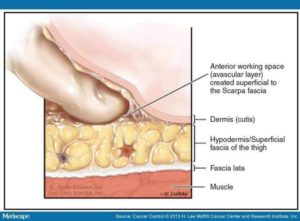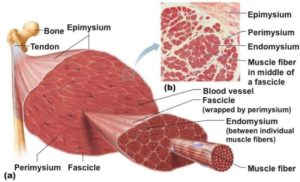TF:LVL2_M5 Fascia Fundamentals
As vibration healers, we should continue to discuss the importance of understanding fascia because it means so much to our craft and to working with sound healing tools like weighted tuning forks. The responses we get from putting a weighted tuning fork on the body for releasing pain-related inflammation is told within the layers of fascia and more specifically the superficial fascia layer which is the focus of this post.
 The image to the left shows a side view of a person’s finger separating the dermis (skin) layer from the underlying hypodermis or superficial fascia layer. You can see how the finger is breaking these fibrous connections between both layers, and you can also see how there are two distinct and separate layers (dermis and superficial fascia). Then underneath we see another layer called the fascia lata or otherwise known as the deep fascia layer separating the superficial fascia from deeper tissue like a muscle. Let’s turn our focus back to that yellow layer of superficial fascia. This layer is also referred to as the adipose layer since the adipose fatty lipids are stored in cells inside of this layer. Most people think of this layer as being a part of the skin and also view it as the adipose layer with a focus on the fat within the layer.
The image to the left shows a side view of a person’s finger separating the dermis (skin) layer from the underlying hypodermis or superficial fascia layer. You can see how the finger is breaking these fibrous connections between both layers, and you can also see how there are two distinct and separate layers (dermis and superficial fascia). Then underneath we see another layer called the fascia lata or otherwise known as the deep fascia layer separating the superficial fascia from deeper tissue like a muscle. Let’s turn our focus back to that yellow layer of superficial fascia. This layer is also referred to as the adipose layer since the adipose fatty lipids are stored in cells inside of this layer. Most people think of this layer as being a part of the skin and also view it as the adipose layer with a focus on the fat within the layer.
Now is the time to change your perspective for the purpose of healing with sound or vibration-based tools like weighted tuning forks. When we use our hands to sense for differences in tissue structure, the inflammation felt underneath the skin IS this yellow layer. Only the lead character in our story is not the yellow fatty stuff. It’s the fiber network that holds the fat cells in place. The superficial fascia layer. That’s right. The fibers, the tight knots, the release, the strawberries through a straw are all coming from the fibers surrounding the fat. We need to start thinking about the fibers themselves since they are the true actor in the search for inflammation and pain. These fibers are the collagen network you saw in the documentary earlier this week. Although it looks like the fascia is packed with adipose, there is much more going on in this layer and it surrounds our entire body just underneath the skin.
This superficial fascia layer has its own communication system separate from the nervous and cardiovascular system. It shares space with both of those systems along with a myriad of other substances like the interstitial fluids attempting to flow into surrounding tissue for nourishment and back to the return route through the lymphatic system. Imagine how crowded this layer must be in normal situations. But then things go bad and the fascia tightens, folds, knots up, and also secretes its own fluids to control the flow of the interstitial fluids.
The fascia cells (fibroblasts) create this very unique gluey substance that can modify itself into varying thicknesses from very thick to watery based on pressure and movements. When we apply a weighted tuning fork on these areas of the superficial fibers, the pressure and vibration causes the thickened fluids (ground substance) to turn into watery liquid similar to shaking up a bottle of catsup. This process accounts for the rapid release and strawberries through a straw phenomenon we feel with our sensing hand. Now you have just released a bit of pressure and allowed some blocked interstitial fluid to begin flowing in the right direction, the lymphatic system to start flowing again to clean and remove it, and the nerve endings can stop sending pain signals.
 In the image to the left, you can see the deep fascia layers wrapping around the muscle fibers like the sections of an orange. Each grouping of muscle fibers are wrapped in fascia. A grouping of wrapped muscle fibers (fascicles) are wrapped again and again until the final muscle group is wrapped with very organized fascia fibers specially designed for muscle movement.
In the image to the left, you can see the deep fascia layers wrapping around the muscle fibers like the sections of an orange. Each grouping of muscle fibers are wrapped in fascia. A grouping of wrapped muscle fibers (fascicles) are wrapped again and again until the final muscle group is wrapped with very organized fascia fibers specially designed for muscle movement.
Then the fascia fibers transition into and become the tendon which ultimately connects to the bone which is also wrapped the made of fascia.
